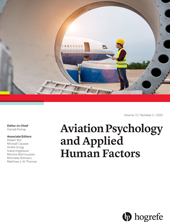Effects of Fatigue on Cognitive Performance in Long-Duration Simulated Flight Missions
Abstract
Abstract. Fighter pilots may be exposed to extended flight missions. Consequently, there is increasing concern about fatigue. We investigated the effects of fatigue and cognitive performance in a simulated 11-hr mission in the 39 Gripen fighter aircraft. Five cognitive tasks were used to assess cognitive performance. Fatigue was measured with the Samn–Perelli Fatigue Index. Results showed that performance in the non-executive task degraded after approximately 7 hr. Fatigue ratings showed a matching trend to the performance in this task. Performance in tasks taxing executive functions did not decline. We interpreted that fatigue can be overridden by increased attentional effort for executive tasks but not for non-executive components of cognition. Participants underestimated their performance and metacognitive accuracy was not influenced by fatigue.
References
(2007). Fatigue, sleep loss, and confidence in judgment. Journal of Experimental Psychology: Applied, 13(4), 182–196. https://doi.org/10.1037/1076-898X.13.4.182
(2011). Maximizing sensitivity of the psychomotor vigilance test (PVT) to sleep loss. Sleep, 34(5), 581–591. https://doi.org/10.1093/sleep/34.5.581
(2006). Mental fatigue, motivation and action monitoring. Biological Psychology, 72(2), 123–132. https://doi.org/10.1016/j.biopsycho.2005.08.007
(2008). Mental fatigue: Costs and benefits. Brain Research Reviews, 59(1), 125–139. https://doi.org/10.1016/j.brainresrev.2008.07.001
(2008). Alertness management strategies for operational contexts. Sleep Medicine Reviews, 12(4), 257–273. https://doi.org/10.1016/j.smrv.2008.01.002
(2009). Fatigue countermeasures in aviation. Aviation, Space, and Environmental Medicine, 80(1), 29–59. https://doi.org/10.3357/ASEM.2435.2009
(2009). Fidelity and validity of simulator training. Theoretical Issues in Ergonomics Science, 10(4), 305–314. https://doi.org/10.1080/14639220802368864
(2005).
Psychomotor vigilance performance: A neurocognitive assay sensitive to sleep loss . In C. KushidaEd., Sleep deprivation: Clinical issues, pharmacology and sleep loss effects (pp. 39–70). Marcel Dekker.(2005). The neural basis of the psychomotor vigilance task. Sleep, 28(9), 1059–1068. https://doi.org/10.1093/sleep/28.9.1059
(1985). Microcomputer analyses of performance on a portable, simple visual RT task during sustained operations. Behavior Research Methods, Instruments, & Computers, 17(6), 652–655. https://doi.org/10.3758/BF03200977
(2011). Visual search: A retrospective. Journal of Vision, 11(5), 14. https://doi.org/10.1167/11.5.14
(2007). G protection: Interaction of straining maneuvers and positive pressure breathing. Aviation, Space, and Environmental Medicine, 78(4), 392–398.
(2009). Visual search elicits the electrophysiological marker of visual working memory. PLoS One, 4(11), e8042. https://doi.org/10.1371/journal.pone.0008042
(1976).
Metacognitive aspects of problem solving . In L. ResnickEd., The nature of intelligence (pp. 231–236). Lawrence Erlbaum Associates.(2016).
Long duration acceleration . In D. P. GradwellD. J. RainfordEds., Ernsting’s aviation and space medicine (5th ed.pp. 131–156). CRC Press.(2011).
The applicability of human-centered automation guidelines in the fighter aircraft domain . In A. DittmarP. ForbrigEds., Proceedings of the 29th Annual European Conference on Cognitive Ergonomics (pp. 67–74). ACM.(2004). Dictionary of cognitive science: Neuroscience, psychology, artificial intelligence, linguistics, and philosophy, Routledge. https://doi.org/10.4324/9780203486030
(2007). Working memory, attention control, and the N-back task: a question of construct validity. Journal of Experimental Psychology: Learning, Memory, and Cognition, 33(3), 615. https://doi.org/10.1037/0278-7393.33.3.615
(2002).
Metacognition research: An interim report . In T. J. PerfectB. L. SchwartzEds., Applied metacognition (pp. 261–286). Cambridge University Press.(2004). Local and global judgments of confidence. Journal of Experimental Psychology: Learning, Memory, and Cognition, 30(3), 729–732. https://doi.org/10.1037/0278-7393.30.3.729
(2002). Effects of caffeine, sleep loss, and stress on cognitive performance and mood during US Navy SEAL training. Psychopharmacology, 164(3), 250–261. https://doi.org/10.1007/s00213-002-1217-9
(2010). Imaging brain fatigue from sustained mental workload: An ASL perfusion study of the time-on-task effect. NeuroImage, 49(4), 3426–3435. https://doi.org/10.1016/j.neuroimage.2009.11.020
(2012). Effects of sleep deprivation on cognitive performance by United States Air Force pilots. Journal of Applied Research in Memory and Cognition, 1(1), 27–33. https://doi.org/10.1016/j.jarmac.2011.10.002
(1990). Project A validity results: The relationship between predictor and criterion domains. Personnel Psychology, 43(2), 335–354. https://doi.org/10.1111/j.1744-6570.1990.tb01562.x
(2011). Evaluation of eye metrics as a detector of fatigue. Human Factors, 53(4), 403–414. https://doi.org/10.1177/0018720811411297
(2006). Causes and effects of fatigue in experienced military aircrew and the countermeasures needed to improve flight safety. (Air Force Research Laboratory Report No: AFRL-HE-BR-TR-2006–0071). http://www.dtic.mil/dtic/tr/fulltext/u2/a462989.pdf
(2014). The Psychology Experiment Building Language (PEBL) and PEBL Test Battery. Journal of Neuroscience Methods, 222, 250–259. https://doi.org/10.1016/j.jneumeth.2013.10.024
(1996). Consciousness and metacognition. American Psychologist, 51(2), 102–116. https://doi.org/10.1037/0003-066X.51.2.102
(1994). Subjective fatigue of C-141 aircrews during Operation Desert Storm. Human Factors, 36(2), 339–349. https://doi.org/10.1177/001872089403600213
(1994). Predicting pilot and navigator criteria: Not much more than g. Journal of Applied Psychology, 79(6), 845. https://doi.org/10.1037/0021-9010.79.6.845
(1974). Helicopter aircrew fatigue. (Advisory Group for Aerospace Research and Development Advisory. Report No. 69). http://www.dtic.mil/docs/citations/AD0780606
(1993). Strategy selection and metacognition. Educational Psychology, 13(3–4), 259–266. https://doi.org/10.1080/0144341930130304
(1982). Estimating aircrew fatigue: A technique with application to airlift operations. (Report No. SAM-TR-82-21). https://apps.dtic.mil/dtic/tr/fulltext/u2/a125319.pdf
(1986). Mental images and their transformations, MIT Press.
(1971). Mental rotation of three-dimensional objects. Science, 171(3972), 701–703. https://doi.org/10.1126/science.171.3972.70
(1994). Tyrosine reverses a cold-induced working memory deficit in humans. Pharmacology Biochemistry and Behavior, 47(4), 935–941. https://doi.org/10.1016/0091-3057(94)90299-2
(2004). To stress or relax: Neurochemical aspects of activity and rest. Gedrag en Organisatie, 17, 32–42.
(1985). Preattentive processing in vision. Computer Vision, Graphics, and Image Processing, 31(2), 156–177. https://doi.org/10.1016/S0734-189X(85)80004-9
(2019). A dynamic attentional control framework for understanding sleep deprivation effects on cognition. Progress in Brain Research, 246, 111–126. https://doi.org/10.1016/bs.pbr.2019.03.015
(2008). Neuroimaging studies of mental rotation: A meta-analysis and review. Journal of Cognitive Neuroscience, 20(1), 1–19. https://doi.org/10.1162/jocn.2008.20013



